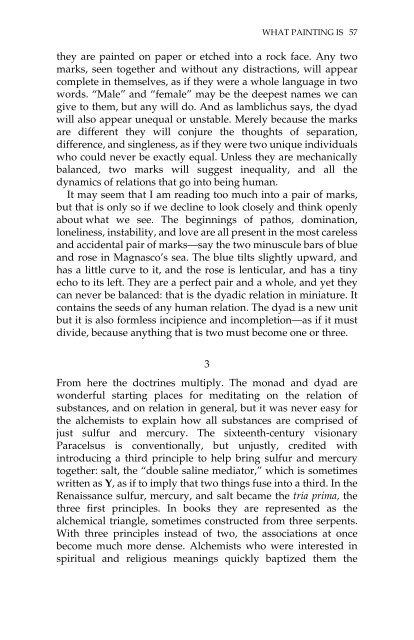What Painting Is: How to Think about Oil Painting ... - Victoria Vesna
What Painting Is: How to Think about Oil Painting ... - Victoria Vesna
What Painting Is: How to Think about Oil Painting ... - Victoria Vesna
You also want an ePaper? Increase the reach of your titles
YUMPU automatically turns print PDFs into web optimized ePapers that Google loves.
WHAT PAINTING IS 57<br />
they are painted on paper or etched in<strong>to</strong> a rock face. Any two<br />
marks, seen <strong>to</strong>gether and without any distractions, will appear<br />
complete in themselves, as if they were a whole language in two<br />
words. “Male” and “female” may be the deepest names we can<br />
give <strong>to</strong> them, but any will do. And as lamblichus says, the dyad<br />
will also appear unequal or unstable. Merely because the marks<br />
are different they will conjure the thoughts of separation,<br />
difference, and singleness, as if they were two unique individuals<br />
who could never be exactly equal. Unless they are mechanically<br />
balanced, two marks will suggest inequality, and all the<br />
dynamics of relations that go in<strong>to</strong> being human.<br />
It may seem that I am reading <strong>to</strong>o much in<strong>to</strong> a pair of marks,<br />
but that is only so if we decline <strong>to</strong> look closely and think openly<br />
<strong>about</strong> what we see. The beginnings of pathos, domination,<br />
loneliness, instability, and love are all present in the most careless<br />
and accidental pair of marks—say the two minuscule bars of blue<br />
and rose in Magnasco’s sea. The blue tilts slightly upward, and<br />
has a little curve <strong>to</strong> it, and the rose is lenticular, and has a tiny<br />
echo <strong>to</strong> its left. They are a perfect pair and a whole, and yet they<br />
can never be balanced: that is the dyadic relation in miniature. It<br />
contains the seeds of any human relation. The dyad is a new unit<br />
but it is also formless incipience and incompletion—as if it must<br />
divide, because anything that is two must become one or three.<br />
3<br />
From here the doctrines multiply. The monad and dyad are<br />
wonderful starting places for meditating on the relation of<br />
substances, and on relation in general, but it was never easy for<br />
the alchemists <strong>to</strong> explain how all substances are comprised of<br />
just sulfur and mercury. The sixteenth-century visionary<br />
Paracelsus is conventionally, but unjustly, credited with<br />
introducing a third principle <strong>to</strong> help bring sulfur and mercury<br />
<strong>to</strong>gether: salt, the “double saline media<strong>to</strong>r,” which is sometimes<br />
written as Y, as if <strong>to</strong> imply that two things fuse in<strong>to</strong> a third. In the<br />
Renaissance sulfur, mercury, and salt became the tria prima, the<br />
three first principles. In books they are represented as the<br />
alchemical triangle, sometimes constructed from three serpents.<br />
With three principles instead of two, the associations at once<br />
become much more dense. Alchemists who were interested in<br />
spiritual and religious meanings quickly baptized them the


